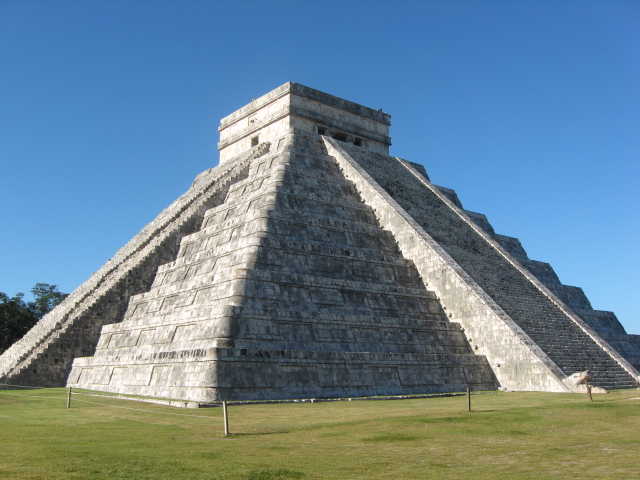
Ruta Maya – Part Four
This is Part Four of a series of articles about Central America’s Aztec and Mayan pyramids and ruins. Updated Sep 2022.
Valladolid
After we toured Tulum and Coba, we travelled by bus to the city of Valladolid. You can find hotels in the $40 range within a few blocks of the bus station. If you have time, the big church in Valladolid is worth a visit, but the main reason we came here is to get an early start on the fantastic Mayan city of Chichen Itza.
El Castillo Chichen Itza

Chichen Itza is one of the best stops on the Ruta Maya. The fabulous pyramid, El Castillo (the castle), sits in the centre of the site. Chichen Itza was one of the largest Mayan cities.
Go Early
Chichen Itza is one of the most visited places in Mexico, with more than a million tourists every year. Therefore, it can get very crowded. However, I had the whole place almost to myself with just a few other people. You can do this if you go early in the morning.
Most tourists arrive on bus trips from cruise ships and hotels in Cancun. They get to Chichen Itza at about 10:30 a.m and leave a few hours later because they must return to their ship or hotel for supper. This is one reason I prefer independent travel over cruise ships, group tours, or all-inclusive hotels.
We travelled to Valladolid by bus the day before our visit and were able to get to the site early. There were only about ten people there for the first couple of hours before swarms of tourists arrived. It is the only time that you can get photos of the pyramid without hundreds of people in the photo. If you have the time and are adventurous, I highly recommend touring the Ruta Maya by regular intercity bus and staying in small, local hotels instead of going on a group tour. Ask at the hotel how to get to the ruin In some locations, there is a local bus, but in some places, you will need to take a taxi. Independent travel is more work but much cheaper than tours where everything is arranged for you.
The Archaeological site of Chichen Itza is magnificent. Teotihuacan has two large pyramids and about 50 smaller ones, while Chichen Itza has only one, but the structures at Chichen Itza are more ornate and in better condition.
The Temple
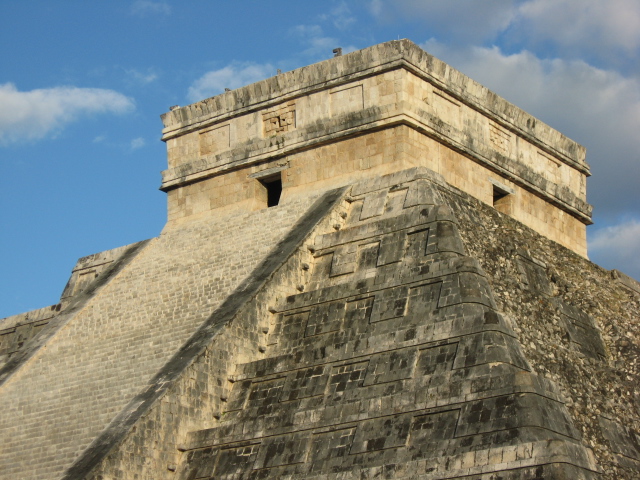
The Pyramids in Egypt are tombs. They were built to house the bodies of dead kings. The Mayan Pyramids in Central America were temples, not tombs. They had a temple on top where the priest would conduct religious ceremonies and sacrifices. Most temples are long gone, but the pyramid at Chichen Itza still has its temple on top. This is one of the few pyramids in Mexico to still have the temple. There are others in Guatemala.
Two sides of the pyramid are badly eroded, with most of the outer layer of stones missing. But the other two sides are in excellent condition. Unlike the other pyramids I have visited, people are not allowed to climb the one at Chichen Itza.
Football Stadium
The pyramid is the main attraction at Chichen Itza, but many other interesting buildings exist. For example, many Mayan and Aztec cities have a ball court, but the one at Chichen Itza is enormous, and I would describe it more as a stadium than a simple ball court. It has a large wall around it and tall structures on the sides that were probably viewing areas for important people of the city.
The Platform of Skulls
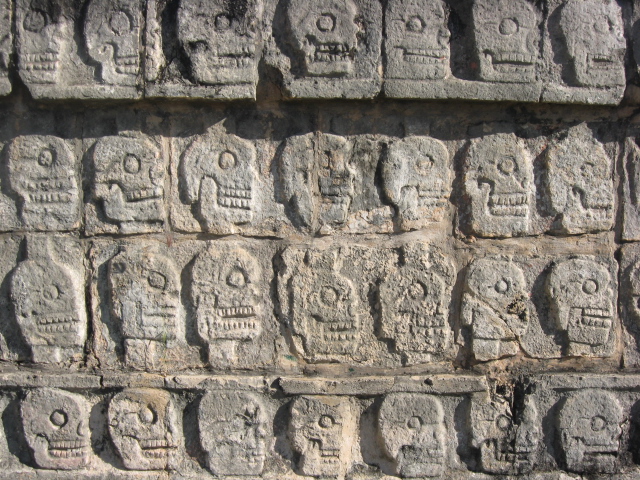
Next to the ball court is the Platform of Skulls. On this platform, enemy prisoners were killed, and their heads were left on display. The sides of the platform are carved with rows of skulls.
The platform of Jaguars and Eagles
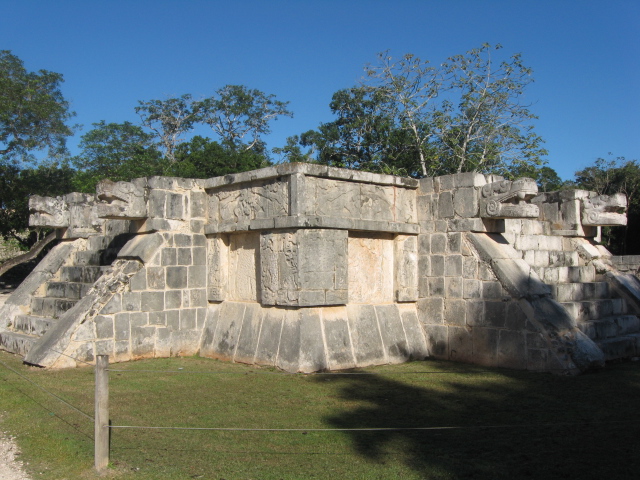
Next to the Platform of Skulls is the Platform of Jaguars and Eagles. The Jaguars and Eagles were warrior societies, and on this platform, the heroes of recent battles were honoured. The sides of the platform have carvings of jaguars and eagles.
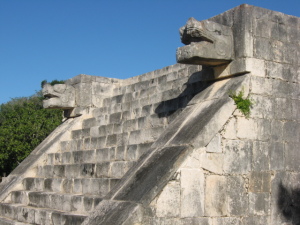 The platform of Chac Mool
The platform of Chac Mool
Proceeding in a circle around the great pyramid, the next building you come to is the Temple Platform of Chac Mool. Here, religious ceremonies were conducted that involved the gods from Venus and other planets. The Mayans were heavily involved in the study of astronomy.
Temple of War
The next building is the Temple of War. Here religious ceremonies were conducted. The ceremonies honoured the city’s warriors. The temple is surrounded by square columns carved with the likeness of heroes of past battles. During the ceremony, human hearts were extracted and offered to the gods.
To the temple’s right is the city’s civic centre, surrounded by 1,000 columns.
Observatory
To the south of the main group of buildings is another group. There is a large observatory where the Mayans studied the stars and planets. This is one of the most interesting buildings in Chichen Itza. Maya knowledge of astronomy was amazingly good. Proof of this is in the construction of the pyramid. The pyramid was built so that twice a year, at sunrise on the spring and fall equinox, a shadow in the shape of a serpent winds its way down the great stairway. How could these people have built a pyramid at such a precise angle to cause this to happen?
Other Buildings
There are several other structures of lesser importance. I do not have space to write about all of them. Some of them have elaborate carvings. Here and there, red and blue paint traces can still be seen. When the city was in use, the pyramid and other buildings were covered in stucco and painted. The carvings were all painted. It must have been a very beautiful place.
A short walk from the city into the forest will bring you to a large cenote (deep water hole). Here virgins were sacrificed to the rain god during periods of drought to make it rain.
While in the woods, keep an eye out for beautiful tropical birds and swarms of army ants on the march.
Houses
The ordinary people at Chichen Itza lived in little huts made of wood, mud and palm branches. Of course, none of the original huts has withstood the ravages of time, but at Chichen Itza, there is a modern reconstruction to show what the huts were like.
In the 13th century, Chichen Itza was the centre of the Mayan civilization in the Yucatan. But in 1461, the stress of constant wars with other cities and overpopulation caused the city to be abandoned. It amazes me that these great cities could just be abandoned. If they were overpopulated, why did all the people leave and not just half? Perhaps the remaining ones would be too few to defend themselves, and they could not all stay for lack of food.
We left Valladolid at 6:30 a.m. and spent the whole day at Chichen Itza. After a nice meal in the restaurant, we arrived back in Valladolid, tired but happy with our day. Our visit to Chichen Itza is one of the highlights of the Ruta Maya, but there are even greater Mayan cities to the south of Mexico in Belize and Guatemala.
Ruta Maya
Click here for other parts of the Ruta Maya tour in Central America.
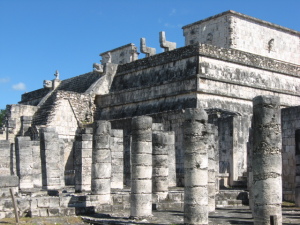
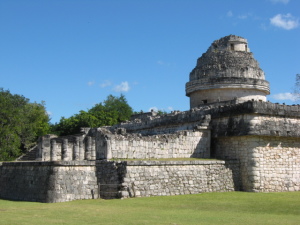
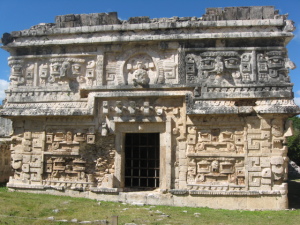
Tom es un excelente trabajo y las fotografías son muy buenas…